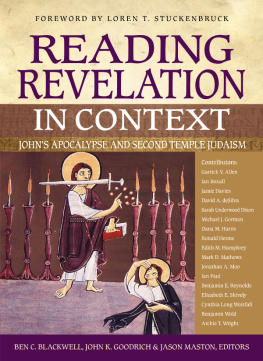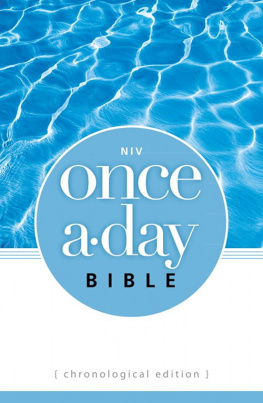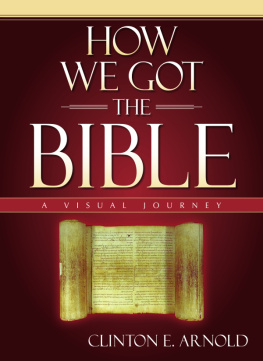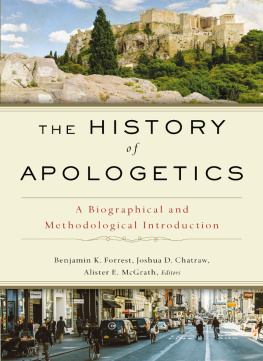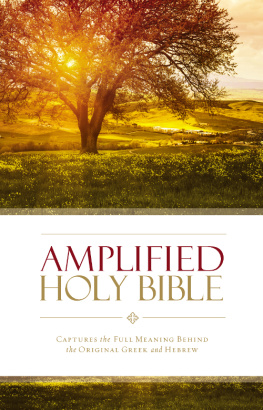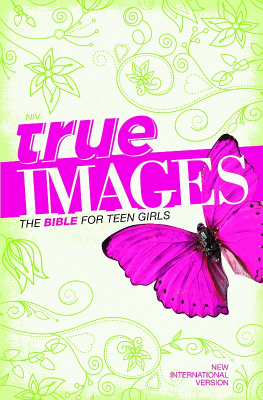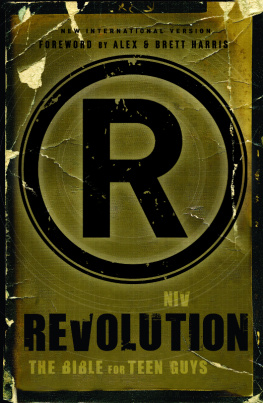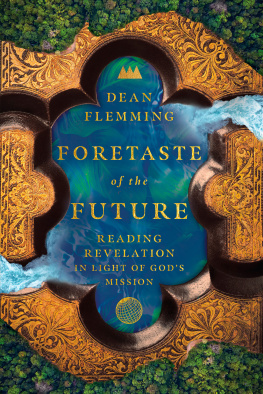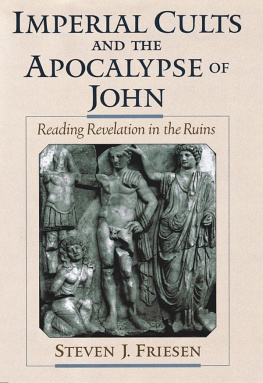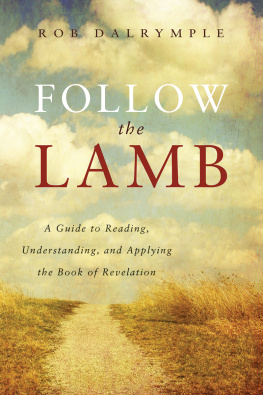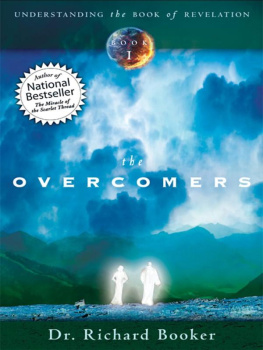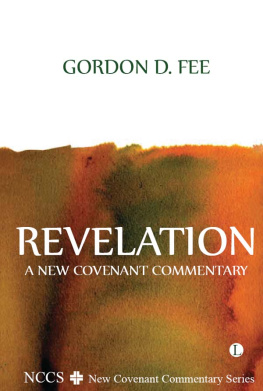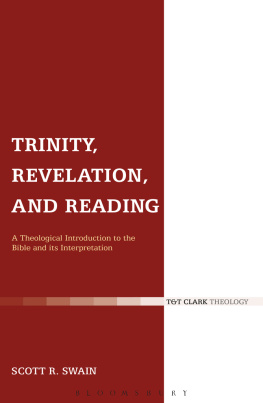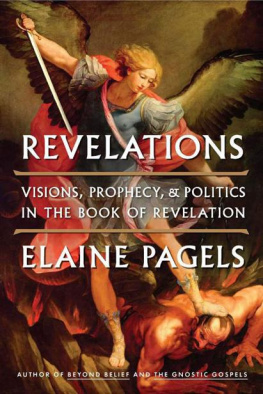ZONDERVAN ACADEMIC
Reading Revelation in Context
Copyright 2019 by Ben C. Blackwell, John K. Goodrich, and Jason Maston
ePub Edition July 2019: ISBN 978-0-310-56624-3
Requests for information should be addressed to:
Zondervan, 3900 Sparks Dr. SE, Grand Rapids, Michigan 49546
Translations of Scripture are contributors own unless otherwise indicated.
Scripture quotations marked NIV are from The Holy Bible, New International Version, NIV . Copyright 1973, 1978, 1984, 2011 by Biblica, Inc . Used by permission of Zondervan. All rights reserved worldwide. www.Zondervan.com. The NIV and New International Version are trademarks registered in the United States Patent and Trademark Office by Biblica, Inc .
Quotations marked NETS are taken from A New English Translation of the Septuagint, 2007 by the International Organization for Septuagint and Cognate Studies, Inc . Used by permission of Oxford University Press. All rights reserved.
Scripture quotations marked NRSV are from New Revised Standard Version Bible. Copyright 1989 National Council of the Churches of Christ in the United States of America. Used by permission. All rights reserved.
Any internet addresses (websites, blogs, etc.) and telephone numbers in this book are offered as a resource. They are not intended in any way to be or imply an endorsement by Zondervan, nor does Zondervan vouch for the content of these sites and numbers for the life of this book.
No part of this publication may be reproduced, stored in a retrieval system, or transmitted in any form or by any meanselectronic, mechanical, photocopy, recording, or any otherexcept for brief quotations in printed reviews, without the prior permission of the publisher.
Cover design: LUCAS Art & Design
Interior design: Denise Froehlich
19 20 21 22 23 24 25 26 27 28 29 / LSC / 15 14 13 12 11 10 9 8 7 6 5 4 3 2 1
Information about External Hyperlinks in this ebook
Please note that footnotes in this ebook may contain hyperlinks to external websites as part of bibliographic citations. These hyperlinks have not been activated by the publisher, who cannot verify the accuracy of these links beyond the date of publication.
To our parents-in-law and grandparents:
Norm and Alice MacDonald,
Rob and Susan Mills,
Bill and Patt Elam,
and Barb Campbell
Mark and Nancy Rush,
and Dotty Rush
Ken and Paula Reed,
David and Julie Sterzing,
Al Murdock and Mildred Reed,
and June Maston
I know your deeds, your love and faith,
your service and perseverance...
(R EVELATION 2:19)
T he present volume offers a welcome series of accessible studies that illustrate both the importance and the possibility of throwing light on what has been and continues to be one of the most influential writings in the New Testament on Christian and even contemporary culture: the book of Revelation.
The book of Revelation has a long history of being celebrated as a key source for knowing the final course of history and of being discredited for its potential to provoke extreme forms of religiosity. Although the book styles itself as an apocalypse, that is, as a disclosure of Jesus Christ (Rev 1:1), it is frequently regarded as one of the most baffling and difficult early Christian writings to interpret. And yet, the epistolary forms that frame the work (chs. 13 and 22:21) suggest that it was written to be sufficiently transparent to audiences of Christ believers among a series of churches in Asia Minor. Thus, in order to communicate, the book demanded a high level of engagement among its hearers and readers, who were expected to receive it with knowing discernment and to adhere to its exhortations (1:3; chs. 23; 13:9; 14:12; 18:4; 22:1819). A significant factor in understanding the apocalypse would have been knowing something about the symbolic imagery on which it drew and how that imagery functioned in its new literary context. Despite offering some interpretive guidance for some of the images (e.g., 1:20; 13:18; 17:914), the symbols remain essentially multivalent in character and resist being reduced into exclusionary single meanings that result from one-to-one decoding. Instead, through participatory imagination, late first-century AD audiences in Asia Minor were invited to position themselves within or in relation to the books symbolism.
Many of the symbols and images in Revelation are reminiscent of, if not directly drawn from, sources that John, the named author, regarded as sacred, whether in the Hebrew Bible or literature from the Second Temple period. While not any one of these sources is ever formally quoted through introductory formulae such as it is written, as it says, or thus, almost every verse of the text employs language that alludes to one or more of them. Scholars have, in particular, observed in Revelation the presence of tradition associated with Daniel, Isaiah, Ezekiel, Jeremiah, Exodus, and Zechariah, while significant influence and/or parallels have also been noted, for example, with parts of 1 Enoch (Book of Watchers, Book of Parables, Animal Apocalypse, Epistle of Enoch), 4 Ezra, Joseph and Aseneth, Apocalypse of Zephaniah, and a range of texts among the Dead Sea Scrolls. Finally, words and phrases recall writings found in other parts of the New Testament (the Synoptic Gospels, Gospel of John, and the Pauline Epistles). Some of the connections with sources outside the New Testament and what they mean are amply and beautifully illustrated by the essays in this volume.
Alongside its heavy, though creative, reliance on symbolism found in Second Temple Jewish tradition, Revelation preserves one of the most developed high christologies among New Testament compositions: Jesus, whom the text designates as the Lamb no less than 28 times, shares the throne of God (5:6, 13; 7:910, 17; 22:1, 3). In addition, as the Lamb he is not only the exclusive center for redemption for those who are faithful but is also, in his suffering, the single paradigm after which believers pattern themselves (6:911; 14:45).
Why, we may ask, is it important at all to think about how Revelation is related to other Second Temple writings? At least two reasons come to mind. First, for all the books emphasis on the exalted Jesus close relationship to God, it is in many ways no less Jewish in character. Curiously, in two places, the text complains about those who regard themselves as Jews and are not (2:9; 3:9), implying in some sense the writers claim to identify with a truer form of Judaism. More importantly, Revelation is so completely informed by the contemporary world of Jewish thought that it is impossible to imagine its message apart from it. Thus, even toward the time of its composition near the end of the first century AD, the book shows little signthough written in Asia Minor (well away from Judea) and participating in socioreligious conflict with the Roman Empireof disconnecting from Jewish tradition. Indeed, it demonstrates how much emerging Christian identity in the diaspora could be and was deeply entrenched within Jewish roots from which it could not be separated without losing something essential.
Second, exploring Revelations connection to Judaism reveals how much the text positioned itself within the discourse of Jewish apocalyptic thought and related traditions that circulated in the first-century Mediterranean world. Though often adopting language that seeks to disclose what is to happen in an imminent eschatological future (1:1, 19; 2:16; 3:11; 4:1; 22:67, 12, 20), the book, like foregoing and contemporary apocalyptic literature, also reflects a keen interest in presenting a revealed past and a revealed present. In Revelation, the recent (2:12) and remote past (cf. 13:8) is unmasked as a time of head-on conflict between the worship of God and allegiance to powers thought to be behind the Roman Empire, while the present is divulged as a time when followers of the Lamb are being called to uncompromising faithfulness in the face of economically attractive, yet false and delusional alternatives (chs. 23, 1314, 18). How individual churches addressed in the messages to them in responded to the texts combination of praise and criticism attributed to Christ is not known. However, it cannot be doubted that in a world order thought to undermine the integrity of faith, the writer hoped and, indeed, expected that they would be able to translate the risen Jesus words into sustained and uncompromising expressions of faithfulness. As with Jewish apocalypses, the program of religious loyalty in Revelation combined with resistance to evil compromise, while convinced that the future shall involve a radical transformation that is already at work in the present (cf. 3:8). The intimate connection forged between Christ the Lamb and his followers demonstrates something of how the symbols and motifs the book has adopted from ancient Jewish texts function: they are not merely metaphors or images that point to a reality beyond, but rather are seen

